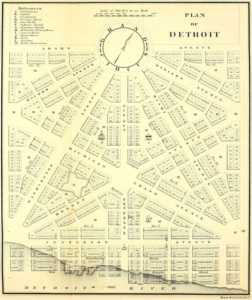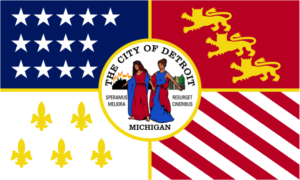 So important was this intersection of cultures and geography, even today Detroit’s city flag reflects its French, British, and American heritage.
So important was this intersection of cultures and geography, even today Detroit’s city flag reflects its French, British, and American heritage.
The Detroit flag incorporates each country that once controlled the city. The lower left quarter represents France with five gold fleurs-de-lis. The upper right quarter represents Great Britain with three gold lions. The lower right and upper left quarters use 13 red and white stripes and stars respectively to represent the original thirteen colonies of the United States.
As Detroit looks to future, it can draw on its historical formation at the crossroads of cultures and geography for guidance. For cities to succeed going forward, they must develop committed efforts to think globally and maximize the use of their culturally diverse communities to gain the full benefits of global markets. Detroit’s long history of building on numerous cultures as well as taking advantage of its geography make it well positioned to succeed in a new post-employment world. Detroit has long been at the forefront of innovation and responsible capitalism Detroit has been at the cutting edge of engineering and manufacturing innovation for over 100 years. In 1903, Henry Ford famously founded the Ford Motor Company and made exceptional use of the assembly line, unlike anything the world had seen before. In addition to other automotive pioneers such William Durant, the Dodge Brothers, Henry Joy, and Walter Chrysler, Detroit was established as the clear global automotive capital. The growth of the auto industry was felt far beyond Detroit. Businesses around the nation created garages to service vehicles and gas stations to fuel up cars, as well as the building numerous factories to make auto parts, glass windows, and rubber tires. Furthermore, this multi-state, multi-plant ecosystem was a precursor to the complex global supply chains that we all benefit from today. Without the innovations created in Detroit over a century ago, raw commodity products sourced anywhere in the world could not be easily designed into user-friendly jackets, automobiles, smartphones, or jumbo-jets. It is not a stretch to say without Detroit our modern wouldn’t exist and wouldn’t be as efficient. With Detroit’s success as an innovate engineering and manufacturing city, companies were able to take advantage of their economic windfalls and be responsible capitalists. In 1914, Ford announced that it would pay its factory workers a minimum wage of $5 per eight-hour day. The news shocked many in the auto industry as $5 per day was nearly double what the average auto worker made. In 1926 the company went a step further, as the company adopted a five-day, 40-hour work week for workers in its automotive factories. Henry Ford said of the decision: “It is high time to rid ourselves of the notion that leisure for workmen is either ‘lost time’ or a class privilege.” Both moves were brilliant management as productivity immediately boosted. These two steps of fair wages and more time off have become ubiquitous globally and now impact every sector of the economy. As the fourth-largest city in the American Midwest and the largest city on the United States–Canada border, Detroit is positioned well for the future. As a standalone economy, Detroit's economy is larger than Chile and would easily be one of the world's fifth largest economies. Today there are over 100 technology startups who call Detroit home. As Recode reports, in 2014, for the first time, there was more venture capital activity in Detroit than Ann Arbor, home of the University of Michigan. According to national education data analyzed by Anderson Economic Group, 10,000 STEM degrees are awarded annually around the Detroit region, which is more than Silicon Valley and nearly 15 percent of Metro Detroit jobs are already in technology. The city of Detroit is built to succeed in the new post-employment environment because of the city’s history of maximizing cultures and geography as well as building upon its innovation and responsible capitalism leadership. It is not a stretch to say without Detroit our modern wouldn’t exist and wouldn’t be as efficient. So the next time someone tells you Detroit isn’t working, say Detroit is succeeding and impacting their life positively daily. Also, look back to the Detroit flag and note the two Latin mottos. One which reads Speramus Meliora and the other Resurget Cineribus, meaning "We hope for better things" and "It will rise from the ashes.” With these mottos powering the city, I believe Detroit is well positioned to resume its claim as one of the world’s greatest cities. No one should underestimate the energy and the drive which has been unleashed just three years after declaring bankruptcy. Not only is remarkable, but Detroit should be inspiring to other cities who can see a path on how to adjust to new global competitive challenges and opportunities. About the author: Marc A. Ross was born and raised in Detroit, Michigan and is a University of Michigan football season ticket holder. Marc is currently the founder of Caracal Global, a full-service communications and public affairs firm, as well as Brigadoon, a yearly gathering of entrepreneurs and thought-leaders. You can follow Marc on Twitter or Instagram @marcaross.

a global affairs media network
Why Detroit is Built to Succeed: Looking at Detroit’s Past to See Its Future
January 18, 2017
 So important was this intersection of cultures and geography, even today Detroit’s city flag reflects its French, British, and American heritage.
So important was this intersection of cultures and geography, even today Detroit’s city flag reflects its French, British, and American heritage.
The Detroit flag incorporates each country that once controlled the city. The lower left quarter represents France with five gold fleurs-de-lis. The upper right quarter represents Great Britain with three gold lions. The lower right and upper left quarters use 13 red and white stripes and stars respectively to represent the original thirteen colonies of the United States.
As Detroit looks to future, it can draw on its historical formation at the crossroads of cultures and geography for guidance. For cities to succeed going forward, they must develop committed efforts to think globally and maximize the use of their culturally diverse communities to gain the full benefits of global markets. Detroit’s long history of building on numerous cultures as well as taking advantage of its geography make it well positioned to succeed in a new post-employment world. Detroit has long been at the forefront of innovation and responsible capitalism Detroit has been at the cutting edge of engineering and manufacturing innovation for over 100 years. In 1903, Henry Ford famously founded the Ford Motor Company and made exceptional use of the assembly line, unlike anything the world had seen before. In addition to other automotive pioneers such William Durant, the Dodge Brothers, Henry Joy, and Walter Chrysler, Detroit was established as the clear global automotive capital. The growth of the auto industry was felt far beyond Detroit. Businesses around the nation created garages to service vehicles and gas stations to fuel up cars, as well as the building numerous factories to make auto parts, glass windows, and rubber tires. Furthermore, this multi-state, multi-plant ecosystem was a precursor to the complex global supply chains that we all benefit from today. Without the innovations created in Detroit over a century ago, raw commodity products sourced anywhere in the world could not be easily designed into user-friendly jackets, automobiles, smartphones, or jumbo-jets. It is not a stretch to say without Detroit our modern wouldn’t exist and wouldn’t be as efficient. With Detroit’s success as an innovate engineering and manufacturing city, companies were able to take advantage of their economic windfalls and be responsible capitalists. In 1914, Ford announced that it would pay its factory workers a minimum wage of $5 per eight-hour day. The news shocked many in the auto industry as $5 per day was nearly double what the average auto worker made. In 1926 the company went a step further, as the company adopted a five-day, 40-hour work week for workers in its automotive factories. Henry Ford said of the decision: “It is high time to rid ourselves of the notion that leisure for workmen is either ‘lost time’ or a class privilege.” Both moves were brilliant management as productivity immediately boosted. These two steps of fair wages and more time off have become ubiquitous globally and now impact every sector of the economy. As the fourth-largest city in the American Midwest and the largest city on the United States–Canada border, Detroit is positioned well for the future. As a standalone economy, Detroit's economy is larger than Chile and would easily be one of the world's fifth largest economies. Today there are over 100 technology startups who call Detroit home. As Recode reports, in 2014, for the first time, there was more venture capital activity in Detroit than Ann Arbor, home of the University of Michigan. According to national education data analyzed by Anderson Economic Group, 10,000 STEM degrees are awarded annually around the Detroit region, which is more than Silicon Valley and nearly 15 percent of Metro Detroit jobs are already in technology. The city of Detroit is built to succeed in the new post-employment environment because of the city’s history of maximizing cultures and geography as well as building upon its innovation and responsible capitalism leadership. It is not a stretch to say without Detroit our modern wouldn’t exist and wouldn’t be as efficient. So the next time someone tells you Detroit isn’t working, say Detroit is succeeding and impacting their life positively daily. Also, look back to the Detroit flag and note the two Latin mottos. One which reads Speramus Meliora and the other Resurget Cineribus, meaning "We hope for better things" and "It will rise from the ashes.” With these mottos powering the city, I believe Detroit is well positioned to resume its claim as one of the world’s greatest cities. No one should underestimate the energy and the drive which has been unleashed just three years after declaring bankruptcy. Not only is remarkable, but Detroit should be inspiring to other cities who can see a path on how to adjust to new global competitive challenges and opportunities. About the author: Marc A. Ross was born and raised in Detroit, Michigan and is a University of Michigan football season ticket holder. Marc is currently the founder of Caracal Global, a full-service communications and public affairs firm, as well as Brigadoon, a yearly gathering of entrepreneurs and thought-leaders. You can follow Marc on Twitter or Instagram @marcaross.


